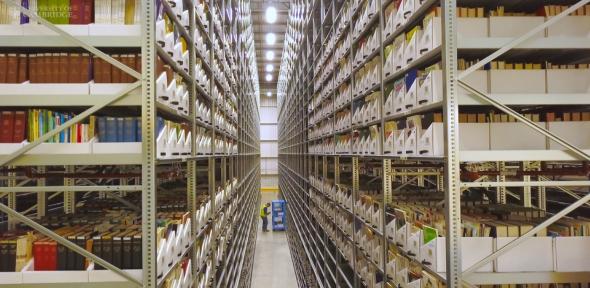
The new Library Storage Facilty (LSF) in Ely has opened, providing storage for hundreds of thousands of books in University library collections.
Visitors to Ely may spot a new landmark on the city’s horizon aside from its famous 1,000-year-old cathedral – a vast, new state-of-the-art storage facility for hundreds of thousands of books belonging to Cambridge University Library and other university collections.
The £17m Library Storage Facility (LSF), which was officially opened today (June 27) by Councillor Mike Rouse, the Mayor of Ely, as well as Cambridge University Librarian Dr Jessica Gardner, has been built to provide a perfect, climate-controlled environment across 65 miles of shelving (the distance between Cambridge and the Houses of Parliament) for its least-requested books – those deemed ‘low-use’. Each row of shelving reaches a height of 11.5 meters, around the height of two adult giraffes.
As a Legal Deposit Library since 1710, Cambridge University Library has been entitled to claim a copy of every book published in the UK and Ireland for more than 300 years – and despite the introduction of electronic legal deposit in 2013 is now full to bursting point.
The vast scale of the University Library collections, which encompasses around nine million books, manuscripts and other physical items, more than one million maps and 2.5million titles on open shelving (the largest open access library in Europe), has been recently brought into focus by our Tall Tales exhibition – where highlights from the million-strong Tower Collections have gone on display for the first time.
However, it is not only the University Library which is set to benefit from the opening of the new facility at Lancaster Way in Ely – the new store will also help to solve overcrowding at many of Cambridge University’s departmental and faculty libraries, as well as help those spaces develop with the needs of students.
Dr Gardner said: “For more than 600 years, Cambridge University Library has been a cathedral of knowledge, collecting and preserving one of the world’s most important and priceless collections of books, maps and manuscripts – from Newton’s personal copy of Principia Mathematica to Darwin’s papers on evolution.
“Now, to make sure we can continue to preserve what is so precious – and meet our ambitions to be a truly global, 21st century collection – we have to make the most effective use of space possible.
“The off-site storage helps to ensure that the most appropriate printed material is kept in the most appropriate and useful location for all our readers. At the moment, material which should and could be on open shelves at the UL is in our closed collections.
“Our new Ely site will support teaching, learning and research across all of Cambridge’s amazing libraries by allowing us all to plan new spaces and rethink our existing facilities and services. Only very low-use material will be considered for ingest for which there is little expected future demand.”
The first book into the store was Douglas Adams: The Hitchhiker’s Guide to the Galaxy: the nearly definitive edition, introduced by Richard Dawkins and Nick Harkaway (London, Heinemann, 2014). Among other low-use material going into the new Ely stores is a wide-ranging and eclectic mix of material that has come to Cambridge University Library under the terms of its Legal Deposit status.
They include periodical magazines across all manner of subjects including astrology, coin and stamp collecting, pigeon, horse and dog racing and hi-fi magazines, and also monographs on a wide range of non-academic subjects from children’s books to cookery books.
Gardner added: “Nearly one hundred years ago, popular culture books of the late nineteenth and early twentieth century were stored for safe-keeping in the famous tower of the University Library. Today they are the subject of our latest exhibition, Tall Tales. In another hundred years the books in the new Ely store will have the same significance for a new generation, looking back on our own.”
Please accept marketing cookies to show embedded content (open cookie preferences)View content (opens www.youtube.com in a new tab)
Facts and figures about the Library Storage Facility
- The LSF can hold up to 106km (65m) of material – the distance between Cambridge and the Houses of Parliament. The site and the building has space and infrastructure to be expanded by a further 25% if and when needed.
- Once all material currently in dark/temporary stores is ingested, the LSF will be 30% full. This is expected to be completed by summer 2019.
- At current estimates, the LSF is not expected to be full until 2030 at the earliest.
- The LSF is situated on Lancaster Way Business Park – the former site of RAF Witchford, a Lancaster Bomber base during the Second World War.
- Material will be stored under strict environmental conditions, on metal shelving, in acid-free cardboard trays.
- The Library van will make the round trip to and from Ely between Mondays and Fridays to deliver books back to the library as requested by readers.
- A fleet of three electric high-level picking machines are employed to shelve and pick material from the LSF. The driver and the cab are lifted to the height of the material being selected.
- At capacity, the LSF is capable of holding in the region of 4,000,000 items.
- The building of the LSF has contributed to the local economy, employing at its peak 50 people during the building phase and a team of full and part-time employees as an operational facility
